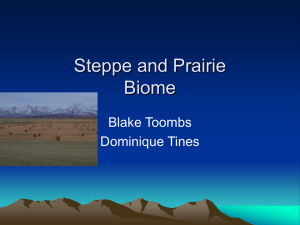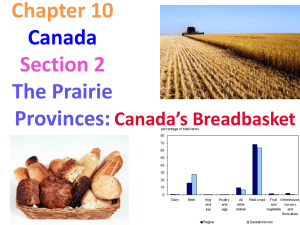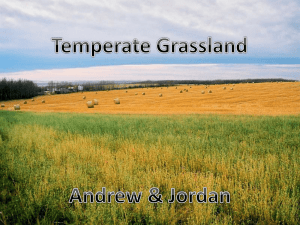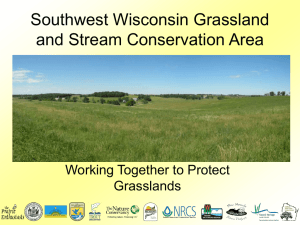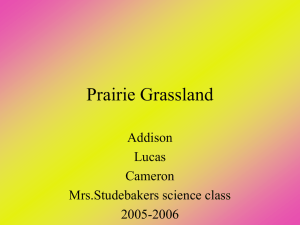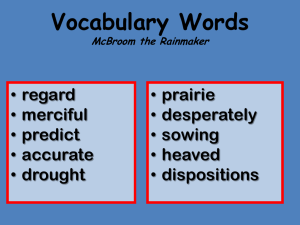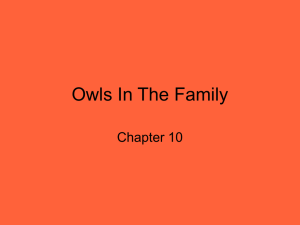The Impact of point source nitrogen pollution on prairie grasslands
advertisement
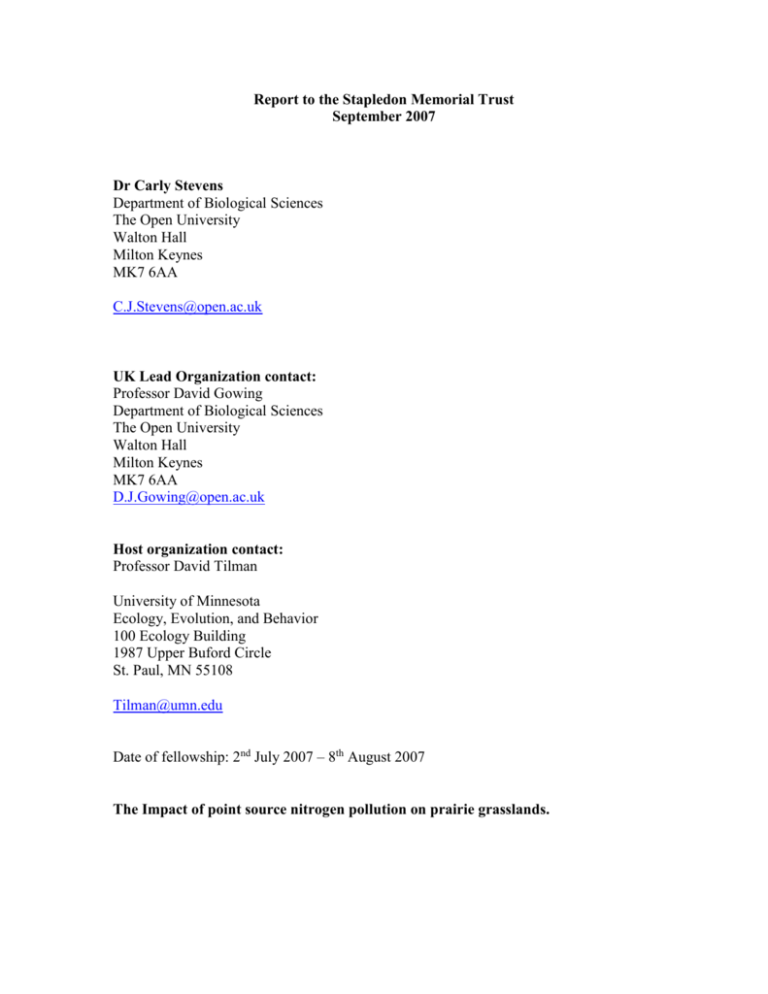
Report to the Stapledon Memorial Trust September 2007 Dr Carly Stevens Department of Biological Sciences The Open University Walton Hall Milton Keynes MK7 6AA C.J.Stevens@open.ac.uk UK Lead Organization contact: Professor David Gowing Department of Biological Sciences The Open University Walton Hall Milton Keynes MK7 6AA D.J.Gowing@open.ac.uk Host organization contact: Professor David Tilman University of Minnesota Ecology, Evolution, and Behavior 100 Ecology Building 1987 Upper Buford Circle St. Paul, MN 55108 Tilman@umn.edu Date of fellowship: 2nd July 2007 – 8th August 2007 The Impact of point source nitrogen pollution on prairie grasslands. The Impact of point source nitrogen pollution on prairie grasslands. Summary of project Prairies once covered large portions of Minnesota but following European settlement many were converted to croplands. There is now less than 1% of the native prairie remaining, this is generally only found in areas that are unsuitable for agricultural use. Prairie grasslands are can be very diverse and contain a number of rare species but the fragmented nature of the remaining prairies means that these sensitive grasslands are often found in close proximity to agricultural areas. In fact, a large proportion of prairie that remains can be found in narrow bands between railways and highways, frequently surrounded by corn crops and feedlots. This means that they are potentially under considerable threat from atmospheric nutrient deposition (from fertilisers and animal waste). In prairie grasslands the plants are adapted to surviving in low nutrient conditions. If nutrient levels are increased the native species aren’t able to compete with more competitive invaders such as vigorous non-native grasses. We know that this habitat is very sensitive from long-term experiments that have been carried out at Minnesota University and we also know that the effects of nitrogen pollution are already apparent in the UK. In both cases declines in species richness and changes in soil chemistry have been apparent. By sampling soils and surveying plant species on gradients with an increasing distance from point sources of nitrogen pollution (feedlots) this project will demonstrate the impacts of nitrogen pollution on prairies. The initial results demonstrate that there are changes in soil chemistry in prairies that are close to feedlots. It is hoped that analysis of these results over the next few months will allow us to build a clear picture of how nitrogen pollution impacts upon prairies. Outline of Research Conducted I visited the University of Minnesota field station at Cedar Creek Natural History Area, Bethel during July and August 2007. The purpose of this trip was to determine if the effects of ammonia deposition on prairie grasslands can be detected outside controlled field trials. The following hypotheses were tested: Species composition will change with increasing distance from the ammonia source becoming more species rich and less dominated by species capable of rapid growth and tall stature, leading to shading of nearby individuals. Biomass will be higher close to the source when additional nitrogen is available for growth. Soil pH, cation exchange capacity and ammonia content will change along the gradient of ammonia deposition; pH is expected to be lower, cation exchange capacity lower, and ammonia content higher close to the source. Changes that have been identified in long term experiments at Cedar Creek Natural History Area will be detected in semi-natural prairie grasslands. Prior to leaving the UK I began the process of identifying potential field locations for the investigation. Prior to European settlement prairies covered large portions of Minnesota but as settlements grew many were converted to croplands. Now, less than 1% of the original native prairie remains. This is usually only survives in areas that are unsuitable for agricultural development. As a result of their scarcity all prairie remnants are mapped by the Department of Natural Resources in Minnesota. This data is freely available on the internet as GIS shape files (http://deli.dnr.state.mn.us/) from state wide surveys of all protected areas and prairie found adjacent to railway lines. Following construction of Minnesota’s railroads, which began in 1862, railroad rights-of-way provided protection for adjacent prairie vegetation. This naturally regenerated following track construction and fires periodically ignited by sparks from passing locomotives stimulated natural wildfires. It was decided that feedlots provided the most appropriate point source for this investigation. Unlike the UK, it is common for animals to be kept housed at all times. Animal Units can be very large, comprising of several hundred cows all housed in large barns or upwards of 10,000 poultry. These animals can potentially produce large amounts of nitrogen pollution in the form of ammonia volatilised from animal waste. The housing of animals throughout the year means that this provides a point source of pollution rather than a diffuse source. Information on the distribution and size of feedlots within the state of Minnesota was gathered with help from Dr Jim Sullivan at Minnesota Pollution Control. A proximity analysis was conducted using the GIS package ‘ARC Info’ to identify all areas of prairie within 250 metres of a feedlot. Upon arrival in Minnesota the next stage of the project was to check this data and identify the best sites for the investigation. At this stage a number of problems were identified with the accuracy of DNR data. Some data was incorrect and a number of the potential sites were found to either not be prairie grassland (but rather another community) or to have deteriorated to such an extent through mismanagement that they no longer resembled prairie grassland. It is possible that this poor condition was also contributed to by atmospheric inputs of nitrogen. Three suitable sites were identified for the investigation: Site 1 was an area of prairie grassland between a disused railway line and a highway in Gaylord, Minnesota. It was on the opposite side of the road to a poultry unit housing 10,000 chickens and turkeys (Figures 1a and b). The prairie ran the length of the feedlot plot and extended a further kilometer along the road. Soils at the site were classed as ‘black soils’ and were very dry. Dominant species in the prairie grassland showed considerable variation along its length but included Rosa arkansana, Aster laevis, Bromus inermis, Solidago canadensis (figure 2) and Poa pratensis. a b Figure 1. Prairie grassland at site 1 (a) and the poultry unit (b). Figure 2. Solidago Canadensis Site 2 was an area of prairie remnant owned by Minnesota Department of Natural Resources and managed for nature conservation. The removal of plant material and soil was by permit only. The site was located in north-west Minnesota near Brooten. The prairie covers approximately 200 acres and represents the best example of mesic blacksoil prairie left in Stearns county. The site was variable in its condition and the influence of surrounding agricultural land. Some of the surrounding area was wooded and there was a river to the north. Beyond this river was a small field and a feedlot with 150 dairy and beef cattle (Figures 3a and b). Dominant species at this site included Pycnanthemum virginianum (figure 4), Liatris palustris, Andropogon geradii, Agropyron repens and Solidago gigantea. In damper areas of this site we encountered Poison Ivy (Rhus radicans) a poisonous plant which leads to an itchy rash. This meant we had to be very cautious when surveying the site. a b Figure 3. Prairie grassland at site 2 (a) and the poultry unit (b). Figure 4. Pycnanthemum virginianum Site 3 was a second area of railroad prairie between a disused railway line and a highway. This site was located near Arlington to the south-west of Minneapolis. Soils at this site were very similar to site 1. Site 3 was adjacent to two feedlots, a small family operation with a maximum 100 beef cattle and a larger unit with several hundred beef cattle (figure 5a and b). The prairie grassland was limited in its extent to a length of 400m. Dominant species in the prairie grassland showed considerable variation along its length but included Sorghastrum nutans, Monarda fistula (figure 6), Andropogon geradii, Petalostemon purpureum, Bromus inermis and Phalaris aeundacea. a b Figure 5. Prairie grassland at site 3 (a) and the poultry unit (b). Figure 6. Monarda fistula At each of the sites the following protocol was followed in the field: 1 Identify a suitable area for the transect with a clear line of sight from the feedlot for 500m 2 Three transects will be used with 2m between them. Sampling points will be at 10m, 50m, 100m, 150m, 200m, 250m, 300m, 350m, 400m and 500m 3 At each sampling point identify plants to a species level in a 1 x 1m quadrat 4 Biomass should be samples from a 10cm x 3m strip along the transect. Biomass samples should be cut at ground level and litter collected 5 Approximately 100g of soil should be collected from the centre of the quadrat at a depth of 0-10cm below the litter layer 6 Store samples in an ice box for transport. 7 On return to the laboratory soil samples should be air-dried in the drying room. Plant samples should be refrigerated and stored below 4oC. Samples collected were returned to the laboratory for analysis where they were analysed for pH, soil ammonia and nitrate, soil moisture and cation exchange capacity. Experience Gained I feel that the experience I gained through this project has been very important to me as an early career scientist. I have previously had very limited experience of working abroad and this is the first time I have conducted an independent research project. Working in another country was a very valuable experience for me. It allowed me to experience different working methods and approaches. Working with new people and in a different laboratory allowed me to see alternative approaches. In conducting species surveys of prairie grasslands I had many new species to learn to identify including some challenging groups such as the Solidagos. I began the process of learning to identify plant species as soon as I arrived at Cedar Creek Research Station. I spent several days in the regenerated prairie surrounding the laboratory looking at the species found there and learning about the experiments that are conducted at the research station. I also benefited from the assistance of an intern student who accompanied me on the site surveys. This student helped me further in identifying plant species. Working closely with an intern student also gave me good experience of supervising staff working with me. This is something I had previously only had limited experience of and I feel that it was very useful. During my stay I spent a number of days working in the soils laboratory at the Department of Behavior, Ecology and Environment. During this time I learnt some new laboratory methods and how to use different analytical machines. I worked very independently during my stay in America which meant there were many things to learn with regard to simply getting about and living from day to day. I felt that this was also important in my personal development. The final aspect of this project that I feel gave me important experience was working on an independent research project and being responsible for making the initial application for funding and planning the project then following this process through to managing the project and its budget. Plans for follow up There are a number of ways in which I plan to follow up my visit to the University of Minnesota. Analysis of collected data – during the course of the visit I gathered large amounts of data which I will be processing with the aim of producing a publication from the project Modeling of Nitrogen deposition – I am keen to model the levels of N emission and deposition for each of the sites I visited and use this information to further explain any trends that I identify. This will be done in collaboration with Dr Jim Sullivan at Minnesota Pollution Control. Comparison of results to experimental findings – I plan to compare the results that I find in my investigation with those of the long term experiments that have been conducted at Cedar Creek. Collaboration on information from long term experiments – during my visit to Minnesota I spent some time working with Dr Chris Clark. We hope to collaborate in the future on drawing together information on long term experiments in the UK and Europe. In order to do this we will be seeking funding for Dr Clark to visit Europe. Internship for Genevieve Miles – Ms Genevieve Miles was the intern student who worked with me during the course of the investigation. We hope to obtain some funding for her to visit the UK to conduct fieldwork with me and gain experience of both working abroad and develop her plant identification skills. Further Analysis of Samples – A larger number of plant and soil samples have been stored at Cedar Creek and I hope that it will be possible to conduct further analysis on these. Develop project further to look at other impacts – I hope that we will be able to seek further funding to develop this work further and look at larger scale impacts. Presentation of results at an international conference and preparation of a paper for publication.

